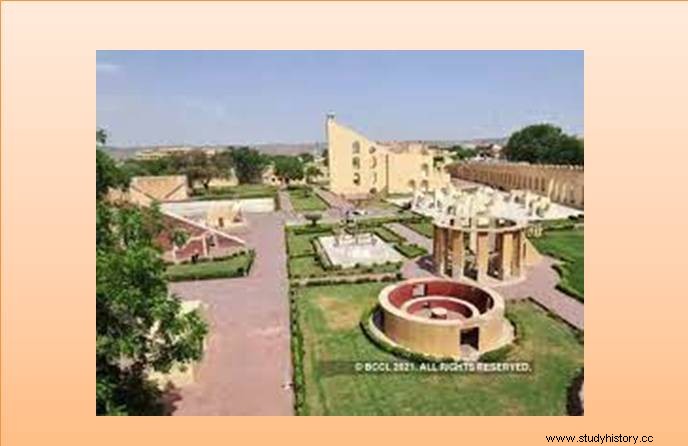
Jaigarh Fort
Sawai Jai Singh got Jaigarh fort built on the eagle mound near Amber fort in 1726 AD. Its structure is very similar to that of Amber Fort. Its length is 3 km in north-south and 1 km in width in east-west. A huge cannon named Jaiban was built in this fort, which at that time was the world's largest cannon on wheels. Amber Fort and Jaigarh Fort are connected to each other by a corridor.
building observatories
Sawai Jai Singh had a keen interest in the study of mathematics, astrology and constellations. Jaising has written about himself that he studied mathematics from childhood which continued till his youth. I have come to know by God's grace that the positions of the planets in the Sanskrit, Arabic and European calendars are different from those revealed by my own observation, especially the position of the moon on the second half. In 1725, he got permission from Emperor Muhammad Shah to build an observatory in Jaisinghpura area of Delhi.
Invention of Observatory Instruments
In the first attempt, Jaisingh used small instruments made of brass metal, due to which small segments of time could not be accurately detected. The biggest weakness of metal instruments was that they expanded and contracted as the temperature increased and decreased. Therefore, with the help of stone and lime, Jai Singh made big machines invented by himself. Jai Prakash, Ram Yantra and Samrat Yantra are believed to be Jai Singh's own inventions.
Emperor Yantra
There is a clock on the Samrat Yantra which shows the time of the Sun at the equator. Below it is a triangular needle which shows the position of the Sun in the form of a shadow. The hypotenuse of its triangular needle is parallel to the Earth's axis and its other side forms a quarter of the sphere which is parallel to the equator. Hours, minutes and degrees are marked at its ends and the three ends of the triangle form separate tangents to the quarter circles, both of which are marked. The height of this instrument of Jaipur observatory is 90 feet and length is 147 feet. The radius of the two quarters of the sphere is 50 feet. The Samrat Yantra of Delhi is a little smaller in size.
Jaiprakash Yantra
Jaiprakash Yantra is a hemisphere with some similar symbols on the inner side. It has stars running from north to south and east to west and the position of the sun is revealed by the shadow of the point where the stars intersect. The position of other planets and constellations can be known by looking at the marked places. The position of the shadow falling on the planet-constellation of which it is sign, keeps telling the position of the constellation. Therefore this instrument is made in two different hemispheres. The diameter of Jaiprakash Yantra of Delhi is 27 feet and that of Jaipur's Jaiprakash Yantra is 17 feet.
Ramayantra
The Ramayantra is open towards two cylindrical heads. Signs are inscribed on its inner and outer walls. They give knowledge of the height of the constellation etc. There are sections open on both sides from the bottom for the convenience of observation. This Yantra also has Dik-Ansha Yantra and Nadi Ring which are useful in astrological observation. Before this such precise instruments could not be made. He also has the distinction of being the first in India. Jaisingh did the work of purification of the Panchang so that the dates could be recognized at the right time. When the eclipse will occur, it can also be correctly predicted. Raja Jai Singh built observatories wherever he lived. Jaipur was his own capital. Ujjain was the capital of his Malwa province. Banaras and Mathura were located in his Agra province. The observatory of Delhi was also built in a suburb named Jaisinghpura which was Jaisingh's own area. He made large instruments in the observatories and provided them the means to know the motion of the constellations accurately. The Mathura observatory is no longer in existence and the Delhi observatory does not function. The remaining observatories still function today.
New Constructions in Amer
Sawai Jai Singh had also built some buildings of Mughal style. The building of 'Diwan-i-Khas' in the fort of Amer was built by him. In this regard, Dr. V. S. Bhatnagar has written- 'Sawai wanted to match the Mughal emperor because of his ambitious nature. That's why he got the buildings of Mughal structure built.'
construction of temples and dharamshalas
Sawai Jai Singh also got some temples built in his city and other places. The temple of Brijnath and the temple of Anand Krishnaji are the best among the temples built by Sawai Jai Singh. To keep his fame everlasting, he also built dharamshalas for the rest of the travelers at Ayodhya, Mathura and Kashi.
